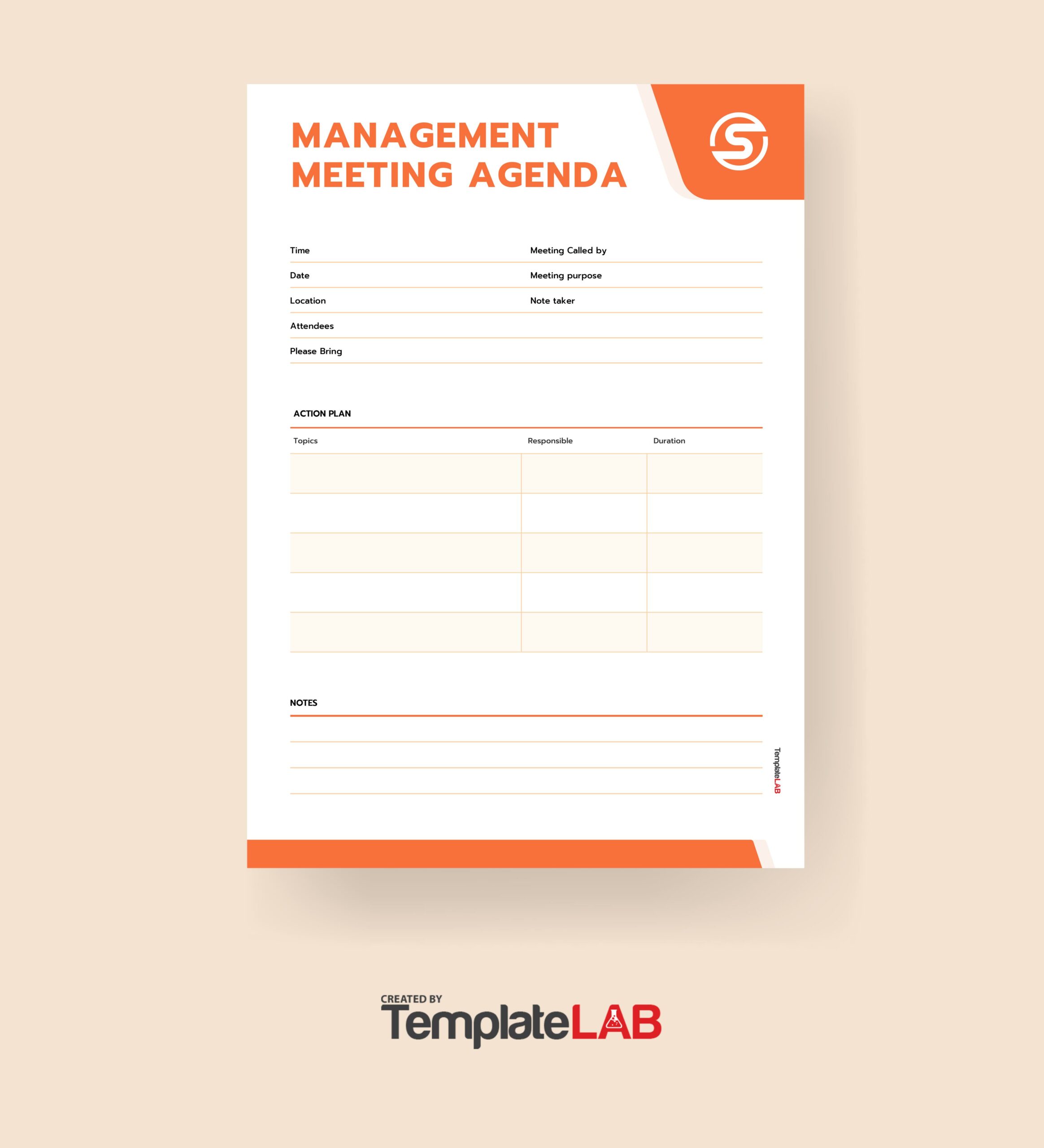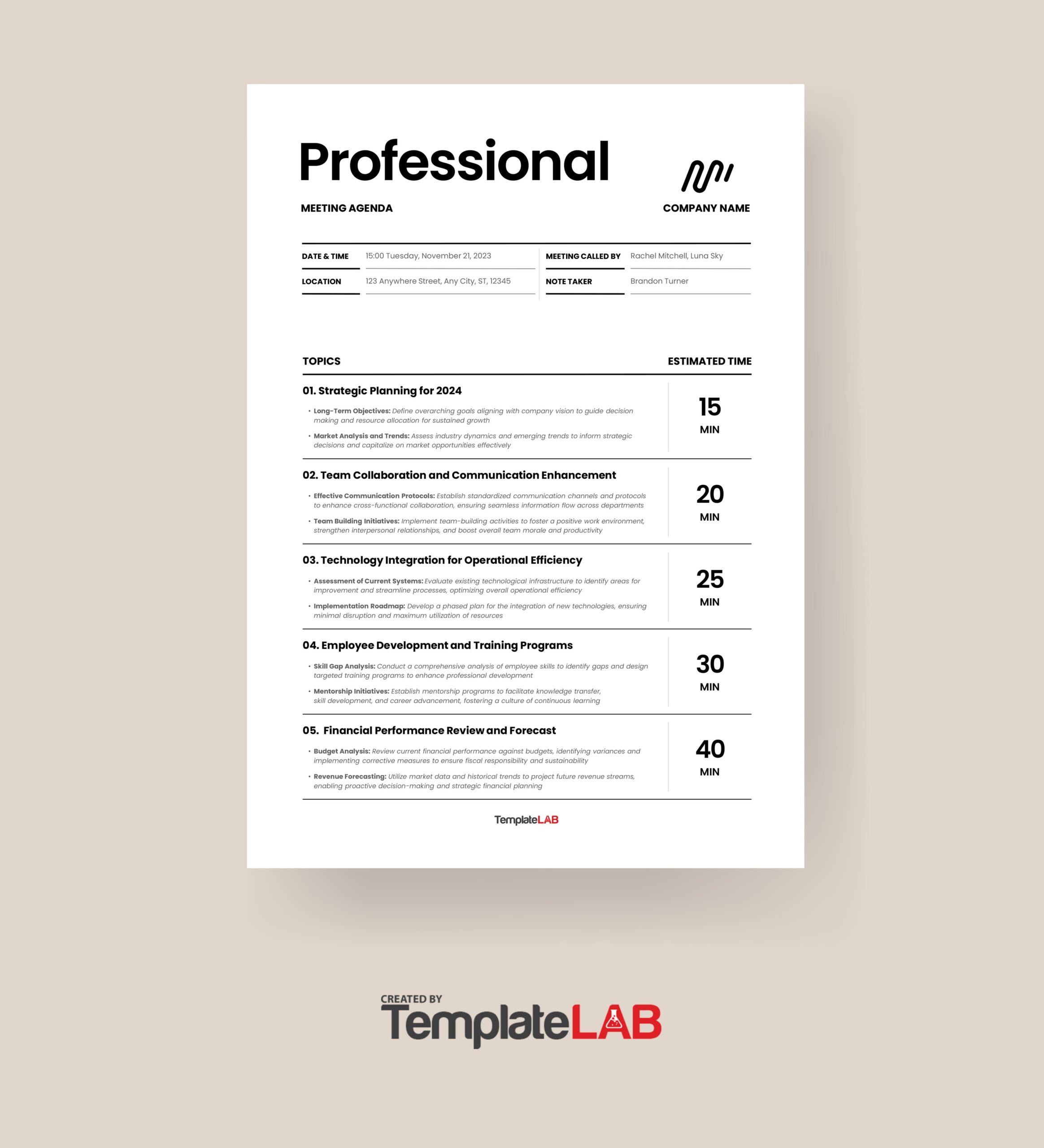Structure within a company is crucial in maintaining strength, growth, and profit. By creating meeting agenda templates, you outline the company’s definition of authority, responsibility, and relationships.
Companies can facilitate a deeper understanding of the goals and foundations of the business by creating effective meeting agenda templates that help teams understand what to expect before a team meeting.
Table of Contents
- 1 Meeting Agenda Templates
- 2 What is a Meeting Agenda Template?
- 3 Meeting Agenda Examples
- 4 Why are Meeting Agenda Templates Important?
- 5 Tips for an Effective Team Meeting Agenda Template
- 6 Meeting Agenda Samples
- 7 How to Create a Basic Meeting Agenda Template
- 8 What is Included in a Meeting Agenda Template?
- 9 Conclusion
A team meeting agenda template should highlight tasks or action items for team members and provide realistic time-frames for completing each task.
If you’re looking to improve the efficiency of your business, this article will outline how, as well as provide tips on free template creation.
Meeting Agenda Templates
What is a Meeting Agenda Template?
A meeting agenda template is a pre-made document that provides structure and outlines important details that must be discussed in an upcoming meeting. A basic meeting agenda template is a reusable resource businesses can use for several meeting agendas.
An efficient board meeting agenda makes the point of the business meeting clear, gives the board of directors and meeting participants time to prepare their agenda items, and ensures everyone is on the same page.
Meeting Agenda Examples
Why are Meeting Agenda Templates Important?
Meeting agenda templates create a dynamic that ensures meetings are productive and goal-oriented. It’s easy to get caught up in what everyone did over the weekend or how the week’s weather report looks. However, with an agenda, small talk is minimized, allowing employees to focus on what needs to be done.
Meetings are known to be quite unpopular. However, the real problem is the lack of preparation and ineffectiveness they often bring.
Having an agenda template can help you decide whether or not a meeting is needed or if you can pop the meeting type and necessary information into a descriptive email that is circulated. Always draft a meeting agenda to determine the need for a team meeting.
Any meeting without an agenda runs the risk of causing disorder because it leaves duties, roles, and team developments unresolved. Meeting agenda templates help with the following:
- Creating effective meetings – Meeting agenda templates assist in cutting down on wasted time since participants can avoid going off-topic and being sidetracked.
- Encouraging team collaboration – Meeting agendas provide everyone with a goal, a plan to reach that goal, and opportunities to work together. Teams will enter the meeting with a clear understanding of its purpose and objective.
- Reaching important milestones – A well-defined agenda aids in time management and keeps team members on track. With a meeting agenda, it’s easier for management or staff to raise a flag and move on to the next topic once a specific discussion exceeds its time limit.
- Standardizing the agenda – Using a meeting agenda template eliminates the need to start from scratch when creating a new format for each meeting. This saves the company a lot of time during the planning process and promotes uniformity for future team meetings and discussion topics.
- Exposing potential pitfalls – A meeting agenda describes what will and won’t be discussed. Consider a meeting agenda as a technique to establish limits and guarantee that only items listed on the agenda will be addressed. You can always note additional discussion points for a subsequent time.
Tips for an Effective Team Meeting Agenda Template
Meeting agenda templates can be used both during the planning of the meeting and while the meeting is in progress. Here are 7 tips to increase the effectiveness of your personalized meeting agenda templates.
- Tip 1: Determine the purpose of the meeting
Determining the meeting’s objective ensures that all attendees are on board, that everyone understands why the meeting’s happening, and how each task is linked to the overall goal. Being specific about the purpose of the meeting allows employees to view the general plan as attainable.
For example, a meeting focused on reducing company expenses could specify that the advertising budget be cut, or the marketing expenses be stretched.
Meetings are best for when there’s too much information to put in an email or when you need to make an immediate decision. - Tip 2: Ask employees for their opinions
No one knows the business as well as those who deal with all the small daily details. Ask attendees for feedback in advance to ensure an effective meeting by keeping them engaged.
You can ask them to bring concerns or questions about the content of the meeting to understand their perspective better. One of the biggest positives of doing this is the increase in employee morale. When employees feel their input matters, it builds a strong company culture based on trust and unity. - Tip 3: Stick to the agenda
Formal meeting agendas are used to ensure that business meetings run efficiently. Diverting from the initial agenda will only waste time and cause confusion. By not sticking to the schedule, you could miss discussing important information.
Try to keep to defined topics rather than switching back and forth between agenda items. This can be achieved with a meeting agenda. - Tip 4: Prepare your own list of questions
If you’ve got some ideas for the subjects you want to cover in the meeting, you can create a list of questions based on the subject. The topic of some meeting agendas is merely listed as a phrase, such as “marketing materials.”
However, by framing discussion points as questions, you can clarify each point’s purpose. You could rather ask, “What type of marketing materials do we need to write for this project.” These questions might help you ensure you’re getting all the information you need for each item on the agenda while encouraging conversation. - Tip 5: Stick to the allocated time frame
Sticking to the time prescribed in the meeting agenda respects people’s time. Assign a time limit to each point that is up for discussion and stick to it as much as possible.
If you’re running behind schedule, consider penciling in a second meeting. Running overtime will affect everyone’s plan for the day, and they might need to catch up on other important tasks. - Tip 6: Assign a note-taker
Establish a note-taker before the meeting so they can record any questions, comments, tasks, and ideas that are discussed. This role can be assigned to an intern or assistant. Alternatively, the function can be rotated, allowing any team member to participate occasionally.
This will make it much simpler for team members to follow the notes and connect them to agenda items if they are taken in the same location as discussion items on the meeting agenda. - Tip 7: Review meeting notes
It’s important to review meeting notes once the meeting has ended in case you missed anything. Take advantage of emails to address important agenda items.
Review meeting notes as a reminder of actionable steps and lingering questions and issues that still need attention. To maintain high levels of responsibility, assign teammates and include due dates in the task items.
Meeting Agenda Samples
How to Create a Basic Meeting Agenda Template
A well-planned team meeting agenda lays the groundwork for insightful and well-targeted discussions. It establishes the atmosphere, offers clarity, and ensures the best use of your team’s time.
Creating a basic meeting agenda template is easy. You only need a few simple points to organize a meeting template that works for you. Here are some items to include in your sample meeting agendas:
- Meeting topic
- Date of the meeting
- Time of the meeting
- Where the meeting will take place (location)
- Meeting goals and objectives
- Documents tasks or reports needed for the meeting
- Agenda item 1:
Allocated time
Purpose
Manager/leader
Minimum three lines for comments about this section.
Agenda item 2:
Allocated time
Purpose
Manager/leader
Minimum three lines for comments about this section.
Agenda item 3:
Allocated time
Purpose
Manager/leader
Minimum three lines for comments about this section.
Agenda item 4:
Allocated time
Purpose
Manager/leader
Minimum three lines for comments about this section.
Additional time for topics that arise during the meeting
Meeting review
Time after the meeting
Purpose of the meeting
Manager
Questions to ask your team after the meeting. Such as:
What did we accomplish with this meeting?
What can we improve to ensure a more productive meeting?
What came up in the forum that needs to be addressed?
What is Included in a Meeting Agenda Template?
The aim of any meeting should be made clear in the meeting agenda. Below are some meeting agenda examples:
- The topic of the meeting – Your objectives should state what you hope to achieve throughout the session. Some common meeting topics include the following:
New project meeting – For any upcoming projects. Consider creating a presentation that describes the project’s objectives, deliverables, and timelines.
Feedback meeting – Structured time for constructive feedback from employers and employees.
Board meeting – To discuss the business matters and outline important steps moving forward.
Agile or scrum meeting – Focusing on sprint reviews, project overviews, potential solutions for improvement, and feedback debriefs.
Onboarding meeting – Introducing any new hires and catching them up with the roles and structure of the company.
Team meeting – General catch-up or discussion on the status of a certain project. Team meetings also assist in resolving issues and scheduling important deadlines. - The goals of the meeting – Highlighting the goals of the meeting is an important step in making sure the meeting goes the way you want it to. The purpose of a meeting could be as simple as:
Planning
Closing projects
Solving problems
Making decisions
Relationship building - List of sub-topics – Ask workers, board members, committee members, and other important shareholders if they have any topics they would like to bring up during the meeting. Ensure the issues are relevant to the meeting’s purpose and desired outcomes. Think carefully about how many subjects you can cover in the meeting’s allotted time.
- Time stamps – Time allocation is crucial in reaching the objectives of the formal agenda. Setting time restrictions for each topic you want to cover will help you stay on track. You can do this by creating slides or presenting the necessary documents and ensuring the subject matter stays within the agenda’s time constraints.
- Time for open dialogue – Schedule time for a quick summary and discussion at the end of the meeting agenda. Make room for questions and a summary of the meeting for those who could have missed something.
- One final summary – Sometimes, meetings bring out things lost between the cracks. Setting aside the time for one last final summary ensures that the entire team covers everything in the meeting agenda. Alternatively, if things were missed, note it for the next meeting agenda template to avoid unproductive meetings.
Conclusion
Meeting agenda templates are useful resources that improve a team meeting, including structure, effectiveness, and productivity. They give discussions a dependable framework and outline, ensuring that crucial subjects are covered and that time is used efficiently.
By creating a unique business meeting agenda template, teams can improve communication, streamline meetings, and produce better results.
























